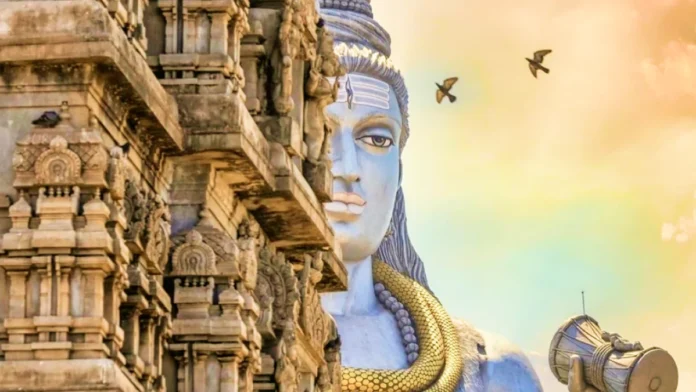There are many temples dedicated to Lord Shiva across India, and each one has its unique charm. From the towering Himalayas to the vibrant cities, these sacred shrines offer a profound experience, blending ancient architecture with profound spirituality. These temples are not only a place of worship but also a significant part of India’s cultural heritage and offer great adventure as well. If you are interested in exploring India’s spiritual side, these 20 Shiv Mandirs are a great place to start. They promise an unforgettable journey, full of cultural enrichment and spiritual significance.
1. Bhimashankar Temple
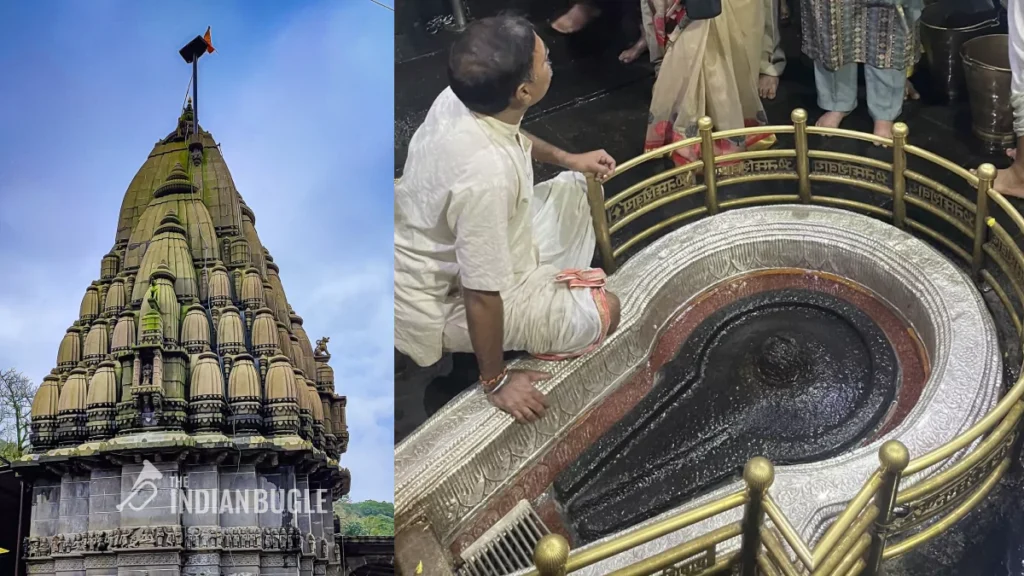
Location : Pune, Maharastra
How to reach : Bhimashankar is a temple town situated 100 km from Pune and 223 km from Mumbai. The nearest railway station is Karjat station. The distance between the station and Bhimashankar is 168 Km, and it takes two hours to reach. The nearest Airport is Pune.
Best time to visit : While the temple is accessible year-round, novice trekkers may find winter ideal, avoiding slippery slopes during monsoons. The prime months of November to February is appropriate to visit the temple.
About the Bhimashankar Temple : Bhimashankar is an ancient shrine located in the Sahyadri hills in Maharashtra, India. It is one of the twelve Jyotirlingas in India. The name Bhimashankar is said to have originated from the river Bhima, which evaporated due to the energy generated during the war between Lord Shiva and the demon Tripurasura. The temple has been visited by historical figures like Chatrapati Shivaji and Rajaram Maharaj. The temple was renovated by the Diwan of the Peshwa, Nana Phadanvis. Worship services are offered every day, and Mahashivratri is an important day for offering worship.
2. Kedarnath Mandir
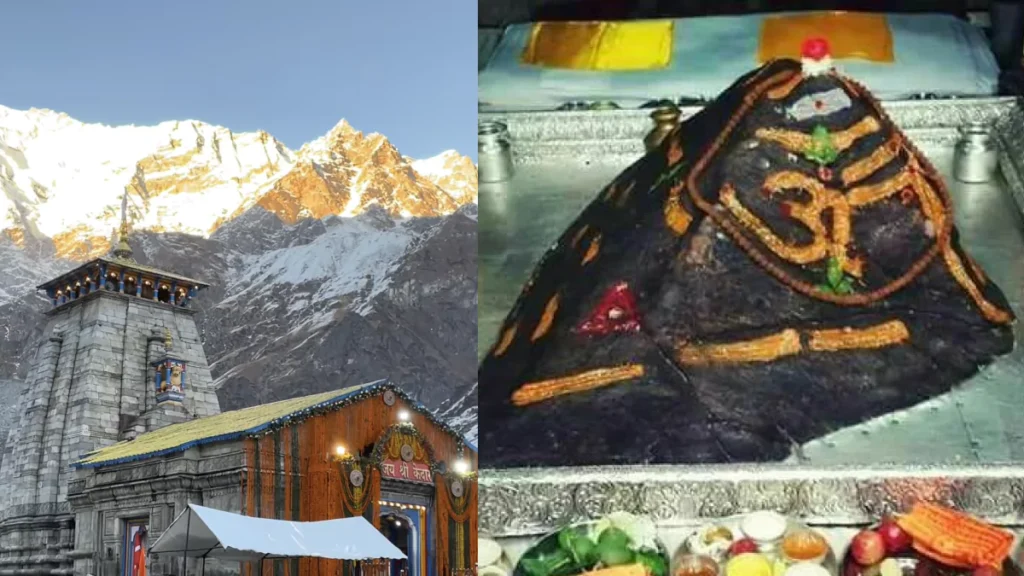
Location : Rudraprayag, Uttarakhand
How to reach : For those opting for train travel, Rishikesh stands as the closest railway station, situated 216 km from Kedarnath. Regularly scheduled taxis and buses provide convenient transportation options. Haridwar facilitates direct hourly bus services to Sonprayag. The nearest airport, Jolly Grant Airport in Dehradun, ensures a smooth journey with taxis readily available to take you to Gaurikund, the last accessible point before Kedarnath. From Gaurikund, a 14 km trek awaits, or you can explore alternatives like a horse ride. However, we strongly discourage the use of such rides to promote animal welfare and discourage cruelty towards animals.
Best time to visit : April to June is the best time to visit Kedarnath as the weather is pleasant and the temperatures usually range between 10 to 15 degree Celsius.
About the Temple : Kedarnath temple holds a special place for people of all religion, being part of both Char Dhams and Panch Kedar. It is also one of the 12 Jyotirlingas dedicated to Lord Shiva in India. According to legend, after the Kurukshetra war, the Pandavas sought redemption for killing their own relatives. Lord Shiva, taking the form of a buffalo, fled to Kedarnath and eventually dived into the ground, leaving his hump on the surface. Other parts of Lord Shiva manifested at Tungnath, Rudranath, Madmaheshwar, and Kalpeshwar, collectively known as Panch Kedar.
The Kedarnath temple, an architectural marvel, is dedicated to Lord Shiva. Its construction using large grey stone slabs raises awe about handling such weight in ancient times. The temple includes a Garbha Griha for worship, a Mandap for pilgrim assemblies, and a conical rock inside worshipped as Lord Shiva in his Sadashiva form.
3. Somnath Mandir, Gujarat
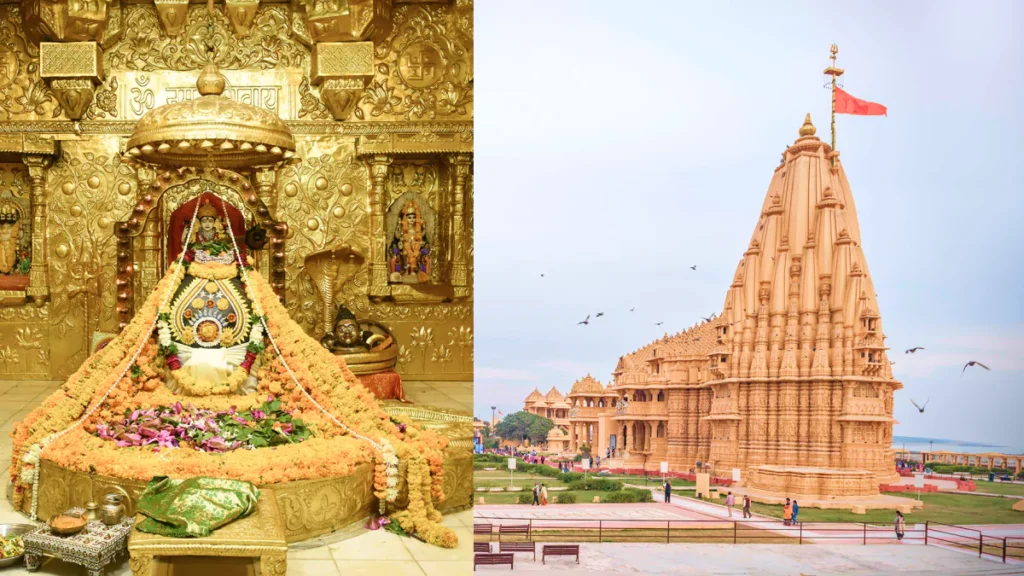
Location : Prabhas Patan, Veraval in Gujarat
How to reach : If you are planning to travel to Somnath by air, Diu Airport (63 km) are the closest airports to Somnath. You can take a cab from either of these airports to reach Somnath comfortably. Somnath Railway Station is another option to reach Somnath as it connects all cities with Somnath. Organized sightseeing bus tour that departs twice daily (10 am and 3 pm) from the Somnath Temple gate.
Best time to visit : The ideal months to visit Somnath are September to March because the winters are very chilly and summer are very hot.
About the Temple : The roots of Somnath Temple trace back to ancient times, with its initial construction predating the Christian era. The temple saw its second iteration between 408 AD and 768 AD under the patronage of the Vallabhi king. Aptly named the ‘eternal shrine,’ it witnessed destruction and resurrection multiple times due to invasions.
Inaugurated on May 11, 1950, the present-day Somnath Temple stands as a symbol of resilience and architectural brilliance. Entrusting Prabhashankar Sompura with its creation, Sardar Vallabhbhai Patel secured its place in modern history. In gratitude to Lord Shiva, Chandra built a Jyotirling which is now known as the Somnath Jyotirlinga. Somnath is one of the 12 Jyotirlingas scattered across India, each holding unique significance in Hindu mythology.
4. Amarnath Temple, Jammu
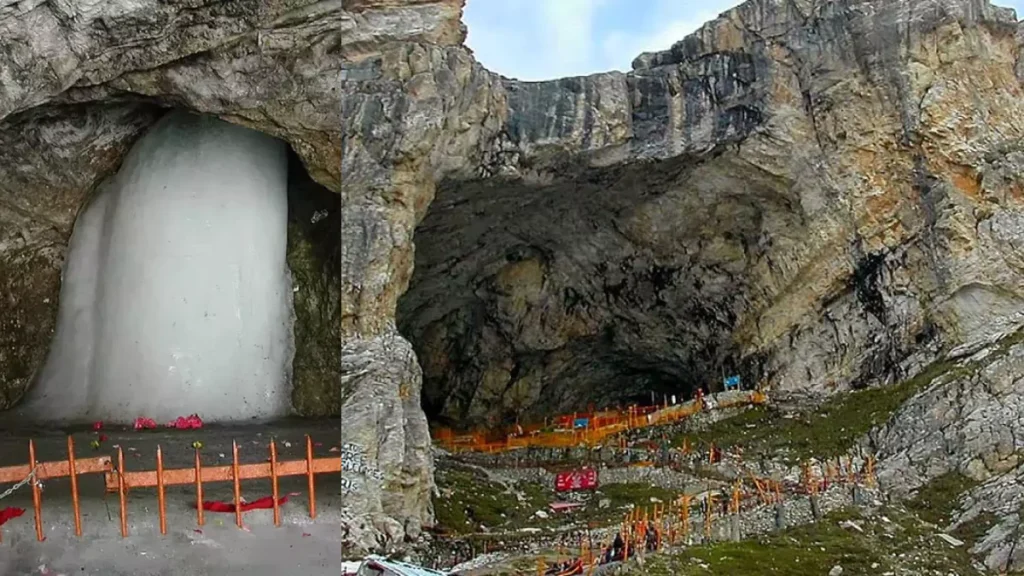
Location : Jammu and Kashmir
How to reach : The main entry point to Amarnath is Srinagar Airport, which is served by large airlines. Situated around 70 kilometres away from Pahalgam, it guarantees pilgrims easy access.
Amarnath is a car trip away, tucked away amid rugged terrain. Take a taxi from Jammu to Baltal or Pahalgam, the pilgrimage’s entry sites. The closest railhead is Jammu station, which is about 178 kilometers away, even though there isn’t a direct train to Amarnath. Hire a taxi from Jammu to Baltal or Pahalgam for your next destination. It takes one to two days to complete the 15 mile hike from Baltal to Amarnath. The Pahalgam route, which is 36–48 km long and takes three to five days, provides a lengthier but more beautiful pilgrimage.
Best time to visit : In the month of Shravan July – September
About the Temple : Buta Malik, a shepherd, stumbled upon the Amarnath Cave, initially discovered by Queen Suryamathi but forgotten over time. He received a miraculous gift of gold coins in place of coal from a saint. Grateful, he sought the saint to express his gratitude but found the cave with a Shivling instead. This led to the rediscovery of the Amarnath Cave, becoming a Hindu pilgrimage site.
Another legend tells of Kashyap Rishi draining the underwater valley of Kashmir, revealing the cave, and Bhrigu Rishi being the first to witness it, making it a revered site. According to Hindu mythology, Shiva revealed the secret of immortality to Parvati in the cave. His belongings scattered across the region, and a pigeon overhearing the secret became immortal, nesting in the cave. Recognized as one of the 18 Maha Shakti Peethas, the Amarnath Temple is a revered destination drawing devotees from across the globe.
5. Mahakaleshwar Mandir, Madhya Pradesh
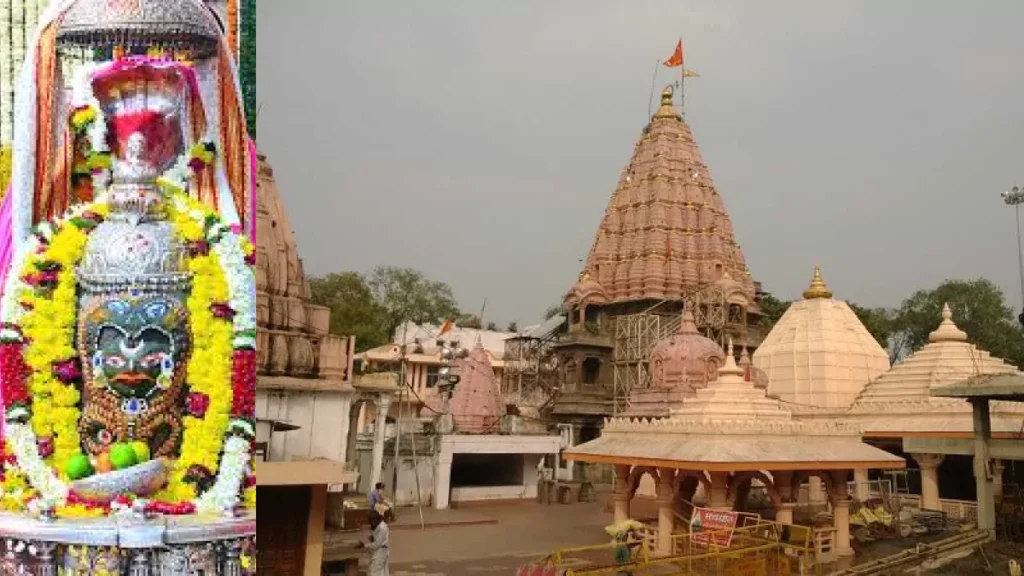
Location : Ujjain, Madhya Pradesh
How to reach : You can reach Ujjain through the Indore airport merely 56 km away. A short one-hour road trip from Indore airport unveils the charm of Ujjain. Ujjain’s well-connected roads extend a warm welcome to those exploring neighboring towns. For train enthusiasts, the Ujjain Junction stands ready as the nearest railway station, adding to the convenience of your travel plans.
Best time to visit : Best time to visit Mahakaal, Ujjain is between October to March , as the weather is very pleasent.
About the Mandir : The Mahakaleshwar Temple, situated in the ancient city of Ujjain, is a remarkable blend of architectural styles and holds immense spiritual significance. As one of the twelve Jyotirlingas, it attracts pilgrims seeking blessings. The temple showcases a fusion of Bhumija, Chalukya, and Maratha architectural elements. These diverse influences create a harmonious symphony of design, reflecting the rich cultural heritage of India. The temple stands as a five-storey structure, each level contributing to its magnificence. The first floor is an underground sanctum, where the presiding deity, Lord Shiva, resides in the form of the Swayambhu lingam. The temple is surrounded by massive walls and features a spacious courtyard. Devotees gather here for worship and contemplation. The temple’s shikhar (spire) is adorned with intricate sculptural finery, showcasing the craftsmanship of the artisans who contributed to its construction. The idol of Mahakaleshwar faces the south, a distinctive feature upheld by the tantric shivnetra tradition. The temple stands on the banks of the holy river Shipra, enhancing its spiritual aura.
The Mahakaleshwar Temple’s architecture, spanning multiple styles, its underground sanctum, and the unique orientation of its idol, all contribute to its revered status as a sacred abode of Lord Shiva
6. Omkareshwar Temple
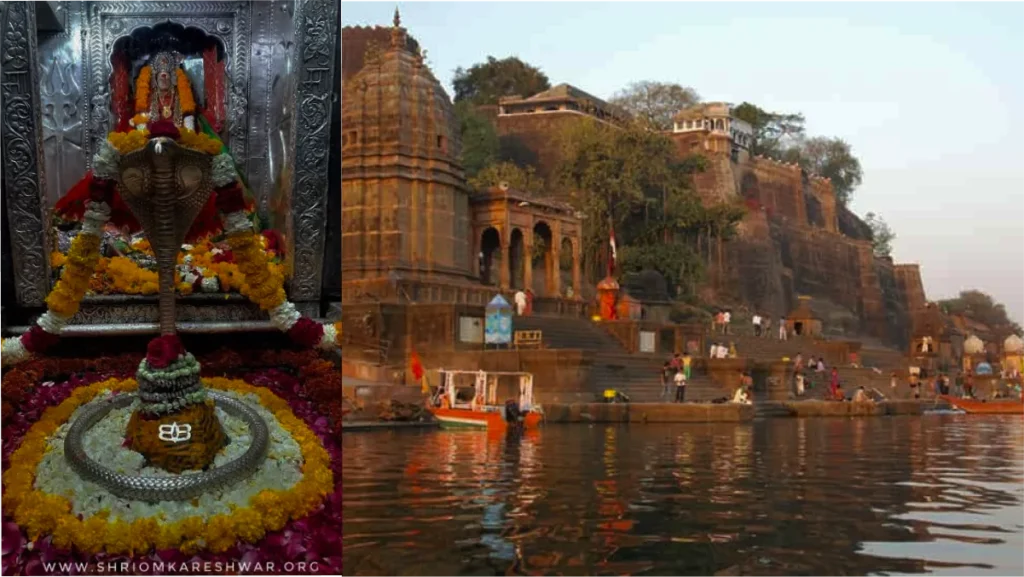
Location : Khandwa, Madhya Pradesh
How to reach : The nearest airport to Omkareshwar is Indore, which is located 77 kilometers away. From there, you can choose to travel by train, bus, or car to cover the remaining 63 kilometers to reach Omkareshwar. If you prefer to travel by road, buses are available from nearby cities. Omkareshwar Road (Mortakka) Railway Station connects Omkareshwar to various cities, but Indore (77 km) is a major railway station.
Best time to visit : Although it is accessible throughout the year, the best time to visit Omkareshwar is from October to March. However, you can also visit during the monsoons as the rains are mostly average here.
About the Mandir : The Omkareshwar Temple, also known as the Omkareshwar Jyotirlinga, holds immense significance in Hinduism. Omkareshwar is one of the 12 revered Jyotirlinga shrines of Lord Shiva. The Omkareshwar Temple is situated on an island called Mandhata, which is in the Narmada River near Khandwa city in Madhya Pradesh, India. The island’s shape is said to resemble the Devanagari symbol “ॐ” (Om), which holds great spiritual significance. There are two main temples within the complex:
- Omkareshwar Temple: Dedicated to Lord Shiva, it is located on the island itself. The name “Omkareshwar” signifies the “Lord of Omkara” or the Lord of the Om sound.
- Mamleshwar (Amaleshwar) Temple: Situated on the southern bank of the Narmada River on the mainland, this temple is dedicated to Lord Shiva as the “Immortal Lord” or “Lord of the Immortals or Devas”.
The religious texts, including the Skanda Purana, Shiv Purana, and Vayu Purana, mention the significance of Omkareshwar. The Omkareshwar Temple follows a Nagara-style architecture, typical of North Indian temples dedicated to Lord Shiva. The temple’s shikhara (spire) rises gracefully, adorned with intricate carvings and motifs. The sanctum sanctorum enshrines the jyotirlinga, symbolizing Lord Shiva’s cosmic presence. Devotees circumambulate the sanctum, offering prayers and seeking blessings. The temple’s mandapa (hall) features beautifully carved pillars and a serene ambiance. The temple walls depict scenes from Hindu mythology, including stories related to Lord Shiva. Intricate carvings showcase celestial beings, animals, and floral patterns. Devotees offer belpatra (leaves of the bilva tree), water, and prayers to the jyotirlinga. The temple’s location amidst the river and hills creates a serene and awe-inspiring atmosphere. Visitors can enjoy panoramic views of the surrounding landscape.
7. Ramanathaswamy Temple
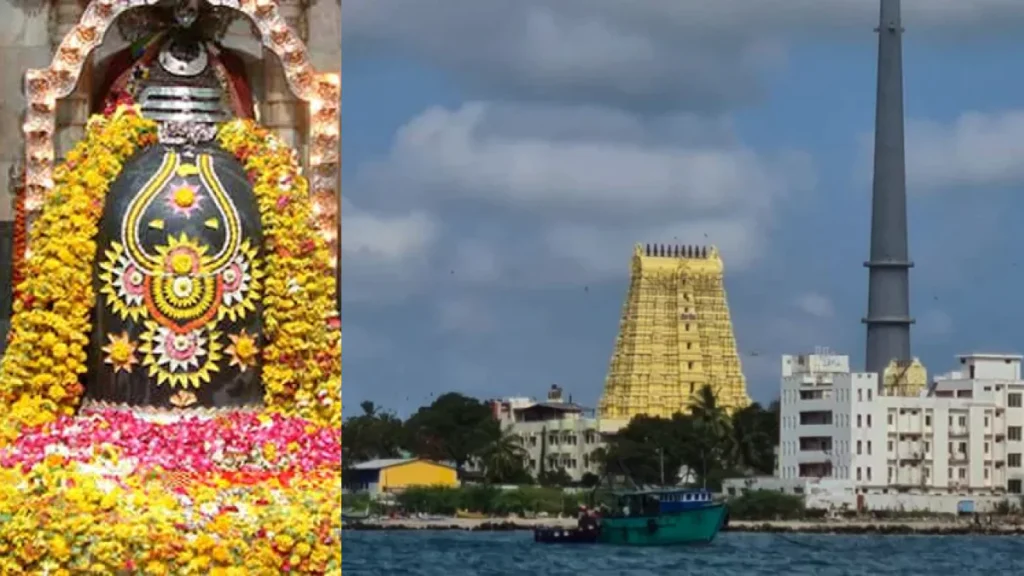
Location : Rameswaram Island, Tamil Nadu
How to reach : Madurai Airport is the nearest airpotrt 147.5 km away from Rameswaram. You can reach Ramanathaswamy Temple by road and rail through Rameswaram. The island can also be accessed through regular ferry services.
Best time to visit : The ideal time to visit is during the winter months, from October to March, when the weather is pleasant, and the festivities are in full swing. Avoiding the monsoon season ensures a comfortable and fulfilling pilgrimage.
About the Mandir : Nestled on Rameswaram Island, the temple stands proudly as a symbol of devotion and heritage. Surrounded by the Bay of Bengal on one side and the Indian Ocean on the other, the location enhances the spiritual atmosphere. Constructed in the Dravidian architectural style, the temple boasts impressive corridors, intricate carvings, and a colossal tower. Within the sacred precincts of Rameswaram Temple, two revered lingams stand as divine symbols. According to tradition, the Ramalingam, fashioned from sand by Lord Rama, takes center stage as the main deity. Alongside it, the Vishvalingam, brought by Hanuman from Kailash, holds significant reverence.
8. Kashi Vishwanath Mandir
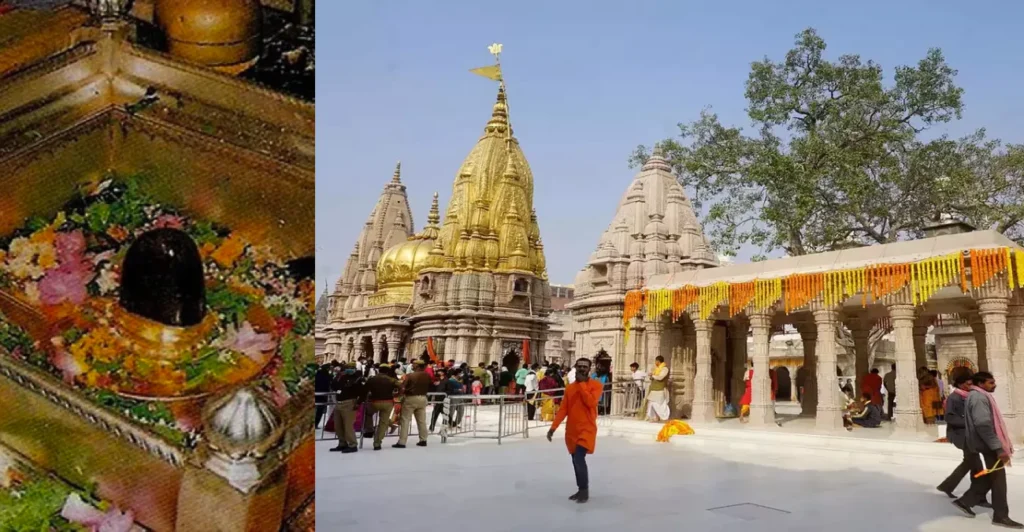
Location : Varanasi, Uttar Pradesh
How to reach : The nearest Airport and Railway Station is Varanasi.
Best time to visit : The temple welcomes visitors throughout the year, but the best time is during the festival of Mahashivratri and in the month of Shavan.
About the Mandir : The Kashi Vishwanath Temple is one of the twelve Jyotirlinga. It is believed that a visit followed by a dip in the holy Ganges paves the way for ultimate liberation or ‘Moksha.’ Folklore suggests that Lord Shiva imparts salvation mantras to those who pass away naturally within the temple premises. Esteemed Hindu saints like Tulsidas, Swami Vivekanand, and Adi Sankaracharya have graced this spiritual haven.
The main temple, constructed in a quadrangular form, is surrounded by shrines dedicated to various deities. The central Shivalinga, made of black stone and housed in a silver altar, stands at 60 cm in height and 90 cm in circumference. Notably, the temple’s structure comprises a spire, a gold dome, and a gold spire atop Vishwanath, adorned with a flag and a trident. The Gyaan Vapi holy well is believed to be the safeguarded site of the Shivalinga from foreign invaders.
9. Lingaraj Temple
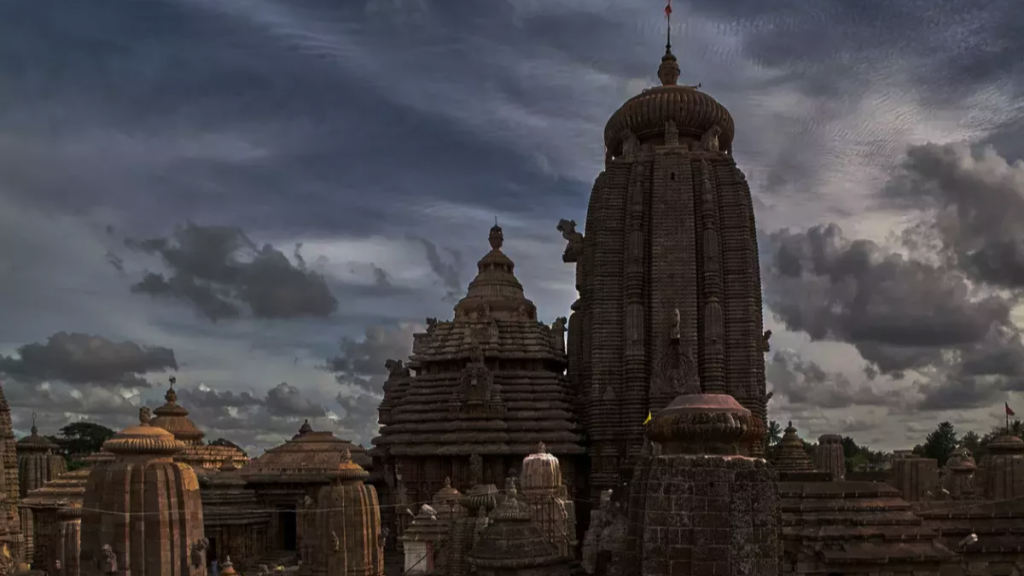
Location : Bhubaneshwar, Orissa
How to reach : Nearest Air port is Biju Patnaik International Airport Bhubaneshwar. Nearest Railway Station is Bhubaneshwar. It is connected to important cities with road.
Best time to visit : Visitors can visit throughout the year as the weather is always pleasant. Still, the best times are Phalgun, Chaitra(March -April) in Mahashivaratri, Ashokashtami, and Chandan Yatra are celebrated on a grand scale.
About the Mandir : The Lingaraj Temple, dating back to the 11th century, was established by King Jajati Keshari. However, historical evidence suggests its existence in a different form since the 6th century, as mentioned in the 7th-century Brahma Puran manuscript, emphasizing the coexistence of peaceful worship for Lord Vishnu and Shiva in ancient times.
A magnificent example of Orissa and Kalinga architectural styles, Lingaraj Temple boasts dark sandstone craftsmanship, covering 2,50,000 sq ft around Bindu Sagar Lake. With a 160-meter compound wall adorned with sculptures, it houses 150 smaller shrines. Divided into Vimana, Jaganmohan, Nata Mandira, and Bhoga-Mandapa, the temple’s intricate design includes pyramidal roofs, honeycomb windows, and detailed carvings.
10. Vaidyanath Mandir

Location : Deoghar, Jharkhand
How to reach : The nearest airport to Deoghar is Deoghar. Kazi Nazrul Islam (RDP) (111.4 km) and Ranchi (191 km). There is a railway station in Deoghar but the busiest railway station is Jashidih railway station.
Best time to visit : Visitors can visit throughout the year as the weather is always pleasant. Shravani mela gives a charm of different levels. Chaitra and Ashwin Durga puja is celebrated with loads of joy.
About the Mandir : Baba Baidyanath Temple is an important site of worship for Lord Shiva’s twelve Jyotirlingas and is also recognized as one of the 52 Shakti Peeths, specifically Haidakhan Peeth. It is believed that the heart of Goddess Sati resides here. The temple’s Lingam, which has a bell-shaped base and is approximately eleven fingers tall, is a sacred symbol and is said to have been pressed into the ground by Ravana. Devotees believe that on the night of the Aridra Nakshatra, Lord Shiva transformed into a Jyotirlinga, making this shrine particularly revered.
The Vaidyanath Dham Temple is an impressive structure with a lotus-shaped design that spans 72 feet. It is a beautiful blend of ancient and modern architectural styles and was constructed by the god Vishwakarma. The temple complex includes 22 shrines dedicated to various deities and is organized into three sections: the main temple, central part, and the entrance gate.
11. Mallikarjuna Swamy Temple
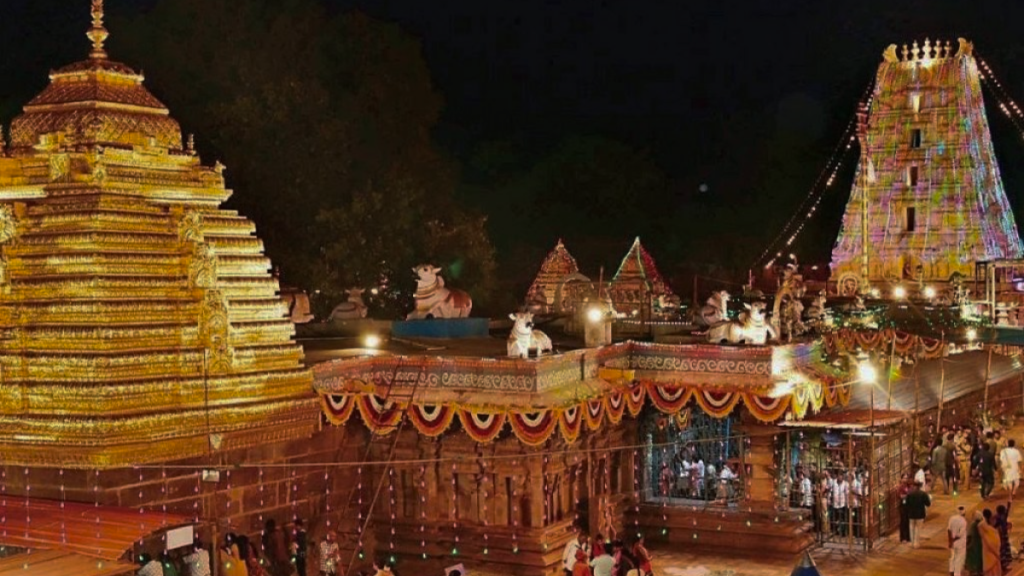
Location : Kurnool, Andhra Pradesh
How to reach : The nearest airport is Rajiv Gandhi International Airport, Hyderabad (250)km away from Srisailam. Markapur Road Railway Station is 85 km away from Mallikarjuna. Regular bus services connect Srisailam to other cities and neighbouring states.
Best time to visit : Devotees believe that visiting the temple during the winter months, particularly around Mahashivratri, brings wealth and fame. The bestt time to visit Mallikarjuna Jyotirlinga is October to February.
About the Mandir : Mallikarjuna Jyotirlinga, the second of the twelve sacred Jyotirlingas, perched majestically atop a hill by the Krishna river. The temple’s rich history dates back to 1 AD during the Shathavahanas empire. Contributions from many rulers enhanced its grandeur. Worship at Mallikarjuna Swamy temple faced interruptions during the Mughal era but resumed during British rule, regaining prominence post-independence.
The mythological tale behind Mallikarjuna Jyotirlinga involves a contest between Lord Ganesha and Lord Kartikeya to determine their marriage order. Ganesha’s clever circumambulation of his parents symbolized going around the world, earning him victory. Mallikarjuna Jyotirlinga is unique, serving as both a Jyotirlinga and a Shakti Peetha. The temple, renowned for its architectural splendor, features towering structures, intricate carvings, and fortified walls.
12. Nageshwar Temple
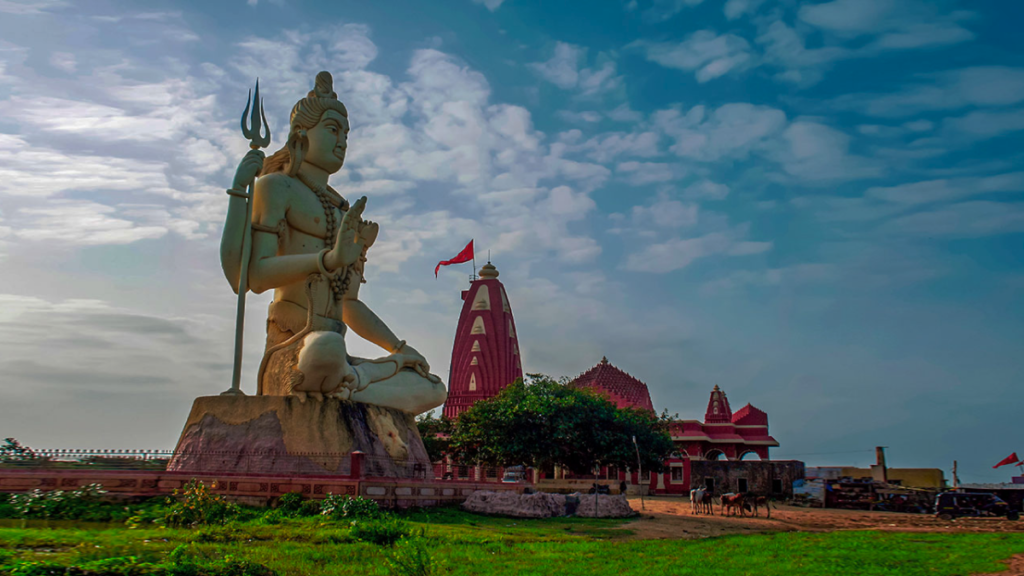
Location : Dwarka, Gujarat
How to reach : Nearest airport is at Jamnagar(137 km). Nearest Railway Station is Dwarka Railway Station 18 km from Nageshwar Shivlinga.
Best time to visit : The best time to visit is during the winter season (October to February), offering a pleasant climate. Maha Shivaratri sees heightened spiritual festivities.
About the Mandir : The temple features a unique south-facing Linga, and a remarkable 80-foot-tall statue of Lord Shiva adds to its grandeur. Constructed with typical Hindu architecture, the Nageshwar Shiva Linga, made of Dwarka Shila, is shaped like a 3 Mukhi Rudraksha.
The temple’s importance lies in being the first of the 12 Jyotirlingas, believed to bring freedom from poisons, snake bites, and worldly attractions to its devotees, as per the Shiva Purana. The legend associated with Nageshwar dates back to the demon Daruka and his captive, Supriya, a Shiva devotee. Lord Shiva, pleased by their devotion, appeared as a Jyotirlinga to protect them.
The temple’s architecture follows Vaastu Shastra principles, representing the sleeping posture of the human body. The Nageshwar temple is in the form of a Human body, the feet (Mahadwar), the hands (Entrance Porch), the abdomen and chest (Saba Mandapa), the worship area of Nandi (Antarala), and the head (Garbhagriha).
13. Trimbakeshwar Temple
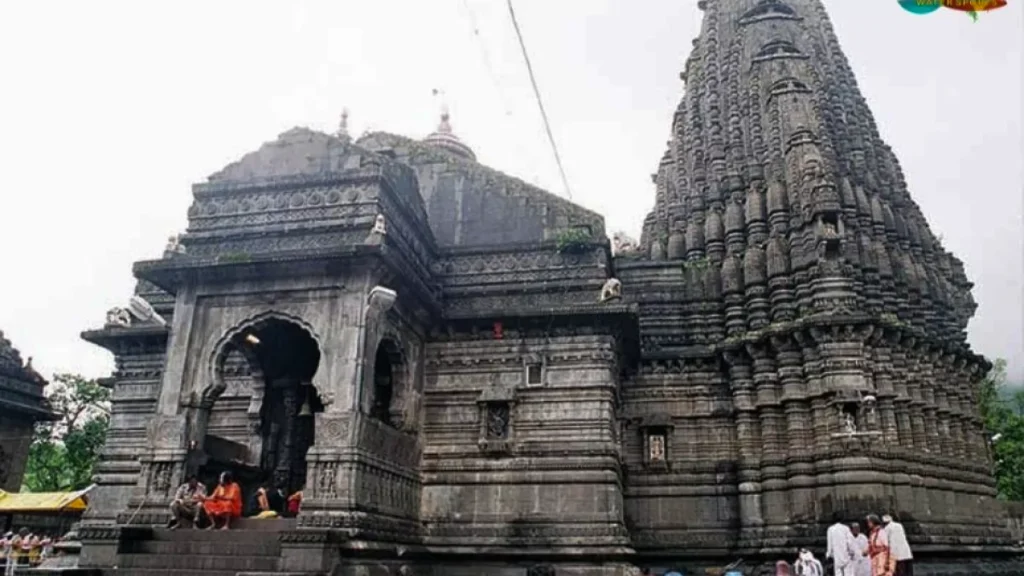
Location : Trimbak, Nasik, Maharashtra
How to reach : The nearest airport is Nashik Airport. Nashik Road railway station is 39 kilometers away from Trimbakeshwar.
Best time to visit : The best time to visit Trimbakeshwar is November to February
About the Mandir : Trimbakeshwar is a holy place located at the beginning of the Godavari River. It is considered one of the twelve Jyotirlingas and is known for its three-faced Linga that represents Lord Brahma, Lord Vishnu, and Lord Shiva.
The temple was built by the third Peshwa Balaji Bajirao (1740-1760) and has entry gates on all four sides – East, West, South, and North. These directions represent different spiritual stages. East represents the beginning, West represents maturity, South represents fulfillment, and North represents revelation.
The grand temple is 265 feet long and 218 feet wide. It has significant entry gates and a Nagarakhana on the North side. The temple boasts the Amrutkund, a lake used for worship, and the main sanctum with a self-existent Shiva Linga and Ban Ling that represent Brahma, Vishnu, and Mahesh. The temple complex also houses a marble statue of Goddess Parvati, adding to the spiritual richness of Trimbakeshwar.
14. Shore Temple

Location : Mahabalipuram, Tamil Nadu
How to reach : The nearest Airport to Mahabalipuram is Chennai Airport. (approx.60 km). Nearest Railway station is Chengalpattu Junction ( approx 27 km) from Mamallapuram.
Best time to visit : The best time to visit Shore Temple is October to March, considering the climatic factors.
About the Mandir : The Shore Temple dates back to around 700 CE and stands as a prominent example of early medieval southern Indian temple architecture. Distinguished from its neighboring structures by being constructed from cut stones rather than carved caves, the Shore Temple features two shrines—one dedicated to Shiva and the other to Vishnu.
With its pyramidal kutina-type tower with stepped stories, topped by a distinctive cupola and finial, the temple’s architectural style differs from the northern Indian sikhara.The monolithic temple showcases Dravidian-style architecture, characterized by an enclosed inner shrine, a grand gateway tower, and an outer wall adorned with Nandi figures and stone carvings of deities.
15. Tarakeshwar Temple
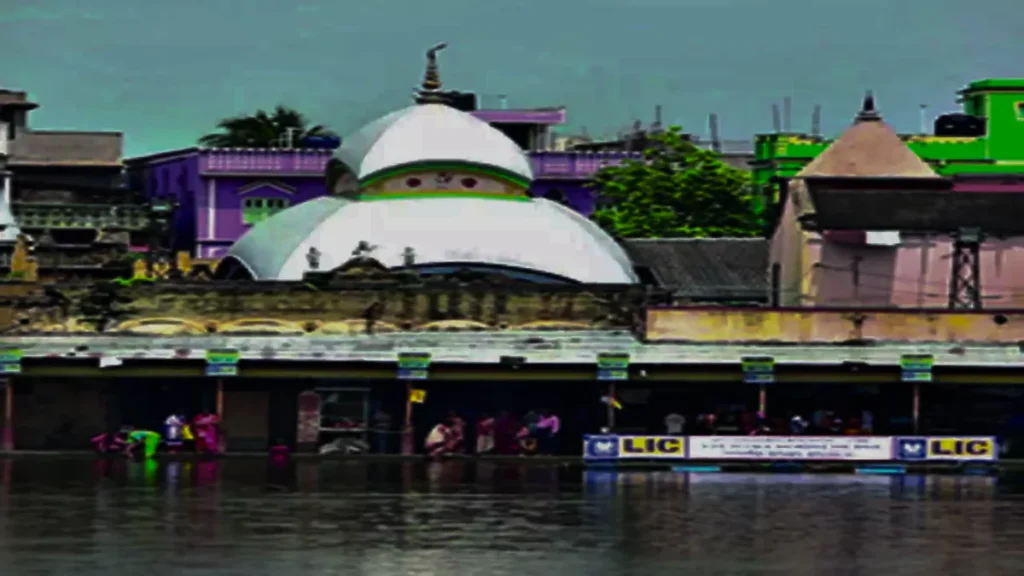
Location : Hoobly, West Bengal
How to reach : The nearest Airport is Subhas Chandra Bose International Airport, Kolkata (approx 30 km )from Tarakeshwar temple. The Nearest railway station is Tarakeshwar railway station (Approximately 1 km) from the temple.
Best time to visit : Visitors visit the place throughout the year, but visiting in Shravan (July- August) is very auspecious.
About the Mandir : This temple is a testament to Bengal-style architecture and the Atchala structure, constructed in 1729 by Raja Bharamall. The presiding deity, Lord Taraknath, represents the fierce form of Lord Shiva, having consumed the venom during Samudra Manthan.
The temple complex includes a Natmandir, and adjacent shrines dedicated to Goddess Laxmi Narayan and Goddess Kali. Dudhpukur, a water tank to the north, holds religious importance, believed to fulfill the wishes of devotees who take a holy dip before visiting the temple. Legend has it that the temple’s origin traces back to a dream of Raja Bharmalla, prompted by a follower of Lord Shiva named Vishnu Das.
16. Annamalaiyar Temple

Location : Thiruvannamalai, Tamil Nadu
How to reach : The Nearest airport is Chennai airport (Madras International Meenambakkam Airport,) approx 200 km. There is a railway Station and a bus stand in Tiruvannamalai.
Best time to Visit : Best time to visit is between November and March.
About the Mandir : The temple is dedicated to Lord Shiva, the Lord of the Red Mountain, who is also known as Annamalajyar, Arunachaleswara or Shiva Lingam. The Shiva Lingam in the temple symbolizes the element of fire or Agni and is considered to be a swayambhu (self-manifested). Lord Shiva’s consort is also known as Goddess Parvati.
The temple is a work of art and architecture that combines different styles of Dravidian architecture, Vijayanagara architecture, and Chola architecture. The walls of the temple are adorned with paintings and writings depicting legends and stories about the temple and the people who used to worship in it.
17. Brihadeswarar Temple

Location : Thanjavur, Tamil Nadu
How to reach : The nearest airport is Tiruchirappalli (approx 61 km). Nearest Railway Station is Trichy Junction,(approx 60 km) from Thanjavur.
Best time to visit : The best time to visit Brihadeswarar Temple is from October to March.
About the Mandir : Built in the early eleventh century CE by the Chola ruler Rajaraja I as a tribute to his conquests and devotion to Shiva, the Brihadeswara Temple is also known as the “Temple of the God of Rajaraja” or the “Rajarajeswarar Kovil” or “The Temple of the great Lord”. Today, the temple is spread over 18 hectares and is surrounded by fortified walls. The main shrine houses the Shiva Lingam, which is one of the largest in India.
The 66-meter-tall vimana, which is the tallest in the world, is made of interlocked granite blocks. The temple is adorned with intricately carved sculptures, paintings and inscriptions depicting aspects of Shaivism, Vaishnavism, and Shaktism. The Nandi statue is a 13-foot-tall, 16-foot-wide Nandi statue carved out of a single rock.
18. Kotilingeshwara Temple

Location : Kolar, Karnataka.
How to reach : The nearest airport is the Kempegowda International Airport, Bangaluru (approx 90 km). The nearest railway station is the Kolar Railway Station(approx 15 km).
Best time to visit : The temple is open throughout the year but the best time to visit is from October to March.
About the Mandir : The main attraction of the temple is the one-of-a-kind ‘Shivalinga’, which is a large statue of Lord Shiva that stands at 33 meters high. It is accompanied by the 11 smaller temples dedicated to other Gods and Goddesses of the temple, such as ‘Vishnu’ and ‘Brahma’, ‘Ganesha’, and ‘Annapurneshwari’. The ‘Nandi’ or ‘bull’ statue at the temple is 11 meters tall and can be seen from a distance.
The temple was established in 1980 by Swami Sarmatya Shiva Murthy. The aim of the temple was to install a total of 1,00,00,00 (about 10 million) “Shivalingas”, which are donated by the devotees who want to seek the blessings of Lord Shiva.
19. Daksheswara Mahadev Temple

Location : Haridwar, Uttarakhand.
How to reach : The Nearest airport is Jolly Grant Airport in Dehradun(approx 35 km), Indira Gandhi International Airport is the nearest international airport in New Delhi. The nearest railway Station is Haridwar.
Best time to visit : The temple is open throughout the year but the best time is between October and March.
About the Mandir : Queen Dhankaur constructed the temple in 1810, and it was reconstructed in 1962. It bears the name of King Daksha Prajapati, who was the father of Sati, Lord Shiva’s first wife. Hindu mythology states that Daksha planned a large yagna but did not invite Shiva because of humiliation, she burned herself alive in the yagna flames because she could not take the insult. This infuriated Shiva, who dispatched his ferocious incarnation, Virabhadra, to destroy the yagna and decapitate Daksha. This incident is thought to have happened at the temple.
The main shrine of the temple is home to a sizable Shivalinga, which is a representation of Lord Shiva. Numerous other shrines honoring various gods and goddesses, including Vishnu, Brahma, Ganesha, Parvati, and Kali, can be found within the temple complex. Devotees also bathe in the Daksha Kund, a sacred tank at the temple that is believed to be filled with Lord Shiva’s tears.
20. Grishneshwar Temple
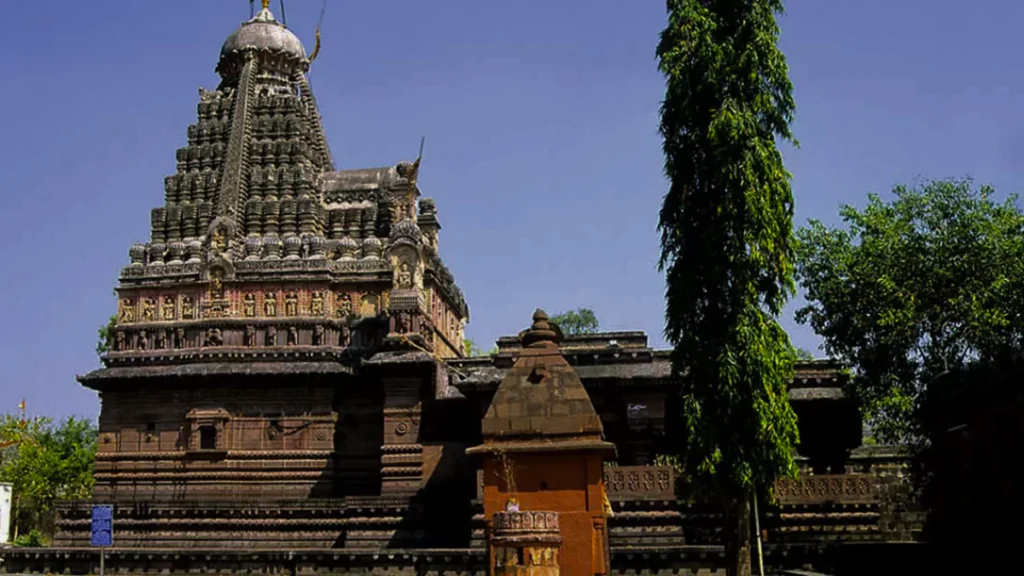
Location : Aurangabad, Maharashtra
How to reach : The nearest airport is Aurangabad Airport (approx 30 km). Nearest Railway Station is Aurangabad railway Station approx 20 km but it is not on the main line. Major Railway Station is Manmad approx 140 km..from Aurangabad.
Best time to visit : October to February is the best time to visit Grishneshwar Temple.
About the Mandir : The Grishneshwar Temple features amazing South Indian-style architecture. This temple has an amazing five-tiered shikhara with intricate traditional carvings. Its current form emerged in the 18th century, under the direction of Queen Ahilyabai Holkar of Indore, after enduring several reconstructions. The temple experienced multiple rebuilds in spite of the ongoing Mughal attacks after the 16th century, with the last one taking place during the Mughal-Maratha wars in the 18th century. Rani Ahalyabai, the queen of Indore, was instrumental in funding the temple’s restoration and ensuring its continued existence.
